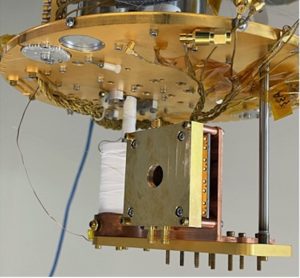At the intersection of quantum science and high-energy particle physics, advances in the development and testing of superconducting microwire single-photon detectors (SMSPDs) have the potential to enhance the ability to detect high-energy particles in particle physics experiments.
The quest to understand particle physics and high-energy particle physics, the fundamental building blocks of the universe, is reaching new heights with revolutionary advances in quantum science and technology (QST). This convergence of fields is creating unprecedented opportunities, particularly in instrumentation, detector design, and exploring physics beyond the Standard Model (BSM). Superconducting sensors optimized for charged particle detection (SNSPD) dramatically improve the ability to perform quantum tomography in collider, enabling detailed detection of quantum entanglement and offering the potential for the unique discovery of dark sector particles.

The intersection of QIS and high energy physics
The synergy between QST and HEP extends beyond theoretical and technological boundaries. On the theoretical side, quantum information science provides intellectual stimulation for innovative models that address deep questions about the quantum universe. This includes developing entanglement-based field-theoretic models, exploring tensor networks, and addressing issues such as decoherence. The concepts of black hole physics, holographic correspondence, and quantum error correction have come together to provide a deeper understanding of the universe at its most fundamental level.
Importantly, this technology overlap focuses on using quantum measurements to detect extremely weak signals characteristic of new physics. Traditional searches for dark matter, such as the weakly interacting large particle (WIMP) paradigm, relied on traditional scattering principles. However, the search for lighter dark matter candidates and new BSM particles requires the superior sensitivity of quantum devices. This new generation of experiments utilizes devices such as SQUIDs (superconducting quantum interference devices), transition edge sensors (TES), microwave kinetic inductors (MKIDs), transmon qubits, and other quantum sensors to search for axions, dark photons, and other exotic phenomena. The most important practical intersection in accelerator-based HEP, and the focus of this article, is the development of next-generation detectors that exploit quantum effects to achieve unprecedented precision, using the recent example of SMSPD arrays.
Breakthrough in Detection: Initial SMSPD Tests at Fermilab
The detection of high-energy particles such as protons, electrons, and pions is a cornerstone of particle physics, but traditional detectors often struggle with the simultaneous requirements of high sensitivity, excellent spatial resolution, and picosecond-level temporal resolution. Superconducting nanowire single photon detector (SNSPD) technology has the potential to revolutionize quantum information science and astronomy and provide solutions with its ultra-low energy threshold and exceptional timing.
To bridge the gap between the small active area of traditional SNSPDs and the needs of large-scale accelerator experiments, researchers at Fermilab, Caltech, and JPL have developed an improved device, the SMSPD array. These devices utilize micrometer-wide superconducting wires to create active areas measuring millimeters square. This is a significant scaling effort.
The first detailed characterization of SMSPD arrays using GeV energetic particles was published in the Journal of Instrumentation (JINST 20 P03001) in 2025. In this fundamental study, SMSPD arrays fabricated with 1.5 μm wide wires on 3 nm tungsten silicide (WSi) films were exposed to 120 GeV of protons and 8 GeV of electrons and pions in the laboratory. Fermilab Test Beam Facility (FTBF). Key findings from this pioneering research include:
The detection efficiency normalized by the fill factor is 60%. The time resolution was 1.15 ns, demonstrating the potential of this technique for precision timing in HEP. The use of a silicon tracking telescope resulted in accurate spatial resolution of 30 μm for protons and 130 μm for electrons and pions.
Advances in cutting-edge technology: Follow-up on the CERN test beam
The success at Fermilab accelerated follow-up research at the CERN Superproton Synchrotron (SPS) H6 beamline, a premier international facility. This subsequent work is detailed in the arXiv preprint “Towards High-Efficiency Particle Detection using Superconducting Microwire Arrays (arXiv:2510.11725)” and focuses on improving sensor design.
In this collaboration, a new 8-pixel 1×1 mm2 SMSPD array was characterized. The sensor features a thicker, optimized 4.7 nm WSi film and narrower 1 μm wide wires aimed at improving both detection efficiency and timing accuracy. The device was tested with 120 GeV hadrons and 120 GeV muons.
The results of the CERN test demonstrated significant performance improvements and solidified SMSPD’s position as a leading candidate for next-generation detectors.
Improved detection efficiency: Detection efficiency normalized by the measured fill factor increased to approximately 75%. Precise timing: Temporal resolution was measured at 130 ps across the array, a significant improvement over the 1.5 ns achieved in initial Fermilab testing. Muon Detection: This study also provided the first SMSPD detection efficiency measurements for muons.
These discoveries represent a major step towards the development of highly efficient charged particle tracking systems with simultaneous precise timing. Such detectors are essential for future accelerator-based experiments, such as the Electron-Ion Collider (EIC), the Future Circular Collider (FCC-ee/hh), and the Muon Collider.
The path to a quantum future: the INQNET program
The technological breakthroughs in superconducting sensors discussed here are not isolated projects but are part of a broader, long-term strategic vision to integrate quantum technologies into basic science, represented by the Intelligent Quantum Networks and Technologies (INQNET) research program.

INQNET was co-founded in 2017 by the California Institute of Technology (Caltech) and AT&T. The strength of this program lies in its unique collaborative model, which brings together key institutions from academia, industry, and national laboratories. Fermilab (FNAL) and NASA’s Jet Propulsion Laboratory (JPL), managed by the California Institute of Technology, were the first key founding members of this collaboration.
The partnership leverages the strengths of each member: industry for rapid resource allocation and expansion, academia for basic research, and national laboratories for large-scale infrastructure and deployment and other experimental capabilities.

INQNET’s core mission is to accelerate the development of scalable hybrid quantum networking and communications technologies, with an initial focus on quantum networks and communications. This program helped establish quantum network test beds such as the Fermilab Quantum Network (FQNET), which demonstrated high-fidelity quantum teleportation over optical fibers. These sensor technologies—the same ones now proven capable of detecting high-energy particles—were originally developed at JPL and commissioned at the INQNET-Caltech laboratory. This highlights the deep connection between HEP’s quantum sensing and broader efforts to build a quantum internet.
This type of consortium program provides the research and technology development framework necessary to advance the fundamentals of quantum physics into functional, advanced technologies. An open challenge and opportunity is how to best integrate this research into the next generation of experiments that promise new discoveries about the fundamental properties of matter, energy, space, and time.
This article will also be published in the quarterly magazine issue 24.
Source link

